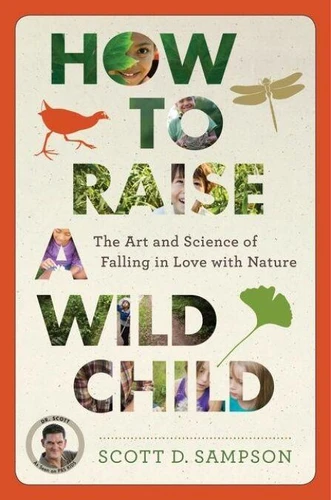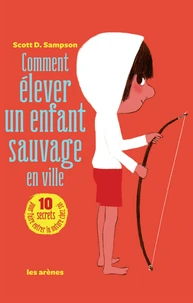How To Raise A Wild Child. The Art and Science of Falling in Love with Nature
Par :Formats :
Disponible dans votre compte client Decitre ou Furet du Nord dès validation de votre commande. Le format ePub protégé est :
- Compatible avec une lecture sur My Vivlio (smartphone, tablette, ordinateur)
- Compatible avec une lecture sur liseuses Vivlio
- Pour les liseuses autres que Vivlio, vous devez utiliser le logiciel Adobe Digital Edition. Non compatible avec la lecture sur les liseuses Kindle, Remarkable et Sony
- Non compatible avec un achat hors France métropolitaine
 , qui est-ce ?
, qui est-ce ?Notre partenaire de plateforme de lecture numérique où vous retrouverez l'ensemble de vos ebooks gratuitement
Pour en savoir plus sur nos ebooks, consultez notre aide en ligne ici
- Nombre de pages320
- FormatePub
- ISBN978-0-544-27919-3
- EAN9780544279193
- Date de parution24/03/2015
- Protection num.Adobe DRM
- Infos supplémentairesepub
- ÉditeurHarper
Résumé
By the beloved and wildly popular host of the PBS Kids show Dinosaur Train, here is the book every parent needs: a rousing call to connect our kids to the natural world, filled with tips and advice. The average North American child now spends about seven hours a day staring at screens and mere minutes engaged in unstructured play outdoors. Yet recent research indicates that experiences in nature are essential for healthy growth.
Regular exposure to nature can help relieve stress, depression, and attention deficits. It can reduce bullying, combat obesity, and boost academic scores. Most critical of all, abundant time in natural settings seems to yield long-term benefits in kids' cognitive, emotional, and social development. How to Raise a Wild Child is a timely and engaging antidote, offering teachers, parents, and other caregivers the necessary tools to engender a meaningful, lasting connection between children and the natural world.
Distilling the latest research in multiple disciplines, Sampson reveals how adults can help kids fall in love with nature-enlisting technology as an ally, taking advantage of urban nature, and instilling a sense of place along the way."In a time when the connection between humans and the rest of nature is most vulnerable, Scott offers parents and teachers a book of encouragement and knowledge, and to children, the priceless gift of wonder."-Richard Louv, author of Last Child in the Woods and The Nature Principle
Regular exposure to nature can help relieve stress, depression, and attention deficits. It can reduce bullying, combat obesity, and boost academic scores. Most critical of all, abundant time in natural settings seems to yield long-term benefits in kids' cognitive, emotional, and social development. How to Raise a Wild Child is a timely and engaging antidote, offering teachers, parents, and other caregivers the necessary tools to engender a meaningful, lasting connection between children and the natural world.
Distilling the latest research in multiple disciplines, Sampson reveals how adults can help kids fall in love with nature-enlisting technology as an ally, taking advantage of urban nature, and instilling a sense of place along the way."In a time when the connection between humans and the rest of nature is most vulnerable, Scott offers parents and teachers a book of encouragement and knowledge, and to children, the priceless gift of wonder."-Richard Louv, author of Last Child in the Woods and The Nature Principle
By the beloved and wildly popular host of the PBS Kids show Dinosaur Train, here is the book every parent needs: a rousing call to connect our kids to the natural world, filled with tips and advice. The average North American child now spends about seven hours a day staring at screens and mere minutes engaged in unstructured play outdoors. Yet recent research indicates that experiences in nature are essential for healthy growth.
Regular exposure to nature can help relieve stress, depression, and attention deficits. It can reduce bullying, combat obesity, and boost academic scores. Most critical of all, abundant time in natural settings seems to yield long-term benefits in kids' cognitive, emotional, and social development. How to Raise a Wild Child is a timely and engaging antidote, offering teachers, parents, and other caregivers the necessary tools to engender a meaningful, lasting connection between children and the natural world.
Distilling the latest research in multiple disciplines, Sampson reveals how adults can help kids fall in love with nature-enlisting technology as an ally, taking advantage of urban nature, and instilling a sense of place along the way."In a time when the connection between humans and the rest of nature is most vulnerable, Scott offers parents and teachers a book of encouragement and knowledge, and to children, the priceless gift of wonder."-Richard Louv, author of Last Child in the Woods and The Nature Principle
Regular exposure to nature can help relieve stress, depression, and attention deficits. It can reduce bullying, combat obesity, and boost academic scores. Most critical of all, abundant time in natural settings seems to yield long-term benefits in kids' cognitive, emotional, and social development. How to Raise a Wild Child is a timely and engaging antidote, offering teachers, parents, and other caregivers the necessary tools to engender a meaningful, lasting connection between children and the natural world.
Distilling the latest research in multiple disciplines, Sampson reveals how adults can help kids fall in love with nature-enlisting technology as an ally, taking advantage of urban nature, and instilling a sense of place along the way."In a time when the connection between humans and the rest of nature is most vulnerable, Scott offers parents and teachers a book of encouragement and knowledge, and to children, the priceless gift of wonder."-Richard Louv, author of Last Child in the Woods and The Nature Principle




